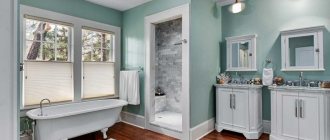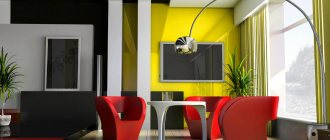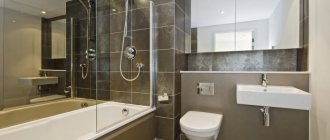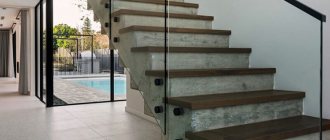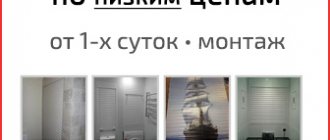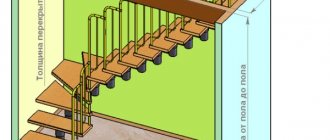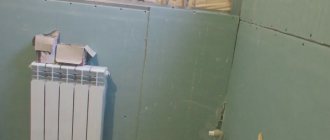Cheap, beautiful, long lasting – what’s the best way to decorate the ceiling?
To choose a method for finishing any surfaces in an apartment, you need to find a balance between your own capabilities and desires. Taken into account:
- design project;
- the cost of the material and its application - when calculating, the cost of the tool is often overlooked, as well as the cost of further care, maintenance in its original form and the time after which replacement is necessary;
- stability when used in various rooms - for example, ceiling wallpaper is not recommended for bathrooms due to humidity and possible mold;
- durability – “set/paint and forget”;
- ease of installation - some cheap materials are difficult to apply, while the installation of others is best left to professionals;
- additional work - for example, leveling surfaces.
For each room you can choose something different. The most popular options are:
- whitewashing, painting;
- wallpapering;
- applying liquid wallpaper;
- gluing tiles;
- hanging structures;
- stretch fabrics.
Let's talk in more detail about their advantages and disadvantages.
Coffered ceiling: from antique architecture to modern interior
The caisson is an architectural, and later decorative, element that has survived several civilizations. Having reached the modern interior from antiquity, the coffered ceiling is again of interest to designers as an original replacement for suspended ceilings.
Which coatings are better?
When choosing the best coating, its beauty, durability and practicality are taken into account. It is especially important to carefully select the cladding of the ceiling surface in unheated rooms and places with high humidity. There it is better to use plastic products or plasterboard structures with a suitable moisture-resistant finish.
Wooden materials can be a good option for a country house, but subject to the use of protective impregnations and a decorative finishing coating. To reduce flammability, the lining is treated with fire retardants, and to protect against damage by mold and rot - with antiseptic impregnations. To increase the resistance of the coating to moisture and dirt, the lining is painted, varnished or impregnated with wax.
Drywall gives unlimited scope in terms of design of the ceiling surface. You can make single-level and complex multi-level structures with built-in lighting and spotlights. In addition, the surface of gypsum plasterboard is finished with different materials (painted, whitewashed, covered with tiles, wallpaper, mosaics, self-adhesive film), which allows you to select the finishing material for the purpose of the room.
Whitewashing or painting
The most inexpensive ways to tidy up your ceiling. The differences are in the materials, their application and surface preparation. In the case of whitewashing, slaked lime is used, which is applied by roller, brush or spray method. The main disadvantages are that such a surface cannot be washed; it attracts dirt and dust well and generously stains those who touch it. It looks rough, and the only advantage of whitewashing is its low cost.
Painting requires a careful approach to leveling the surface and applying compounds in several stages - putty, primer, and painting itself.
This method is good for any living space, as it is not demanding on temperature and humidity, the surface is easy to clean, antifungal components prevent mold from growing, and tinting helps to achieve any color saturation. Finishing the ceiling cheaply and beautifully in this way is the easiest way; the only caveat is the need for careful leveling and preliminary cleaning.
Coloring
This finishing method is becoming increasingly popular. As with the whitewash option, in this case a perfectly flat ceiling is required - almost anyone who has performed this procedure at least once can tell you how to finish it with paint.
Painting technology:
- putty and sand the ceiling;
- prime the surface with diluted water-based paint;
- paint the surface 1-2 times.
“Painting the ceiling with a roller”
Painting the ceiling, compared to other methods of finishing it, has several undeniable advantages:
- special paint is not afraid of water , so painted ceilings can be safely washed and even use special products;
- if desired, you can easily change the color scheme of the room by simply repainting the ceiling;
- this option is quite cheap and accessible.
Read more about painting the ceiling.
Wallpaper
Wallpapering the ceiling is rarely used. This is due to the complexity of the application process, the visibility of imperfections and the selection features. For example, in small rooms you should avoid large patterns - this will make the space even smaller.
Consult with the designer: a combination of wall and ceiling decoration can give the effect of a “box” - a shrinking space.
Smooth material requires a perfectly leveled and puttied surface, so voluminous wallpaper that masks unevenness is often chosen for the ceiling. Another problem is the difficulty of combining the pattern on the rolls and gluing large panels: this is almost impossible to do alone.
An option that combines a paper coating and ease of painting is liquid wallpaper. A mixture of cellulose chips and decorative compounds is applied like putty. No particularly careful leveling of the ceiling is required; it is possible to use different colors and create patterns. The only drawback is the high price. It is also not recommended to use wallpaper in general in the bathroom - the porous structure will be an excellent home for mold.
What is a suspended ceiling made of aluminum slats: features and advantages
Metal, in particular aluminum suspended ceilings, can be of several types: slatted, cassette or lattice. The first type is the most popular because it has the following advantages over the others:
- the installation procedure is extremely simple and does not present any difficulties even for a beginner;
- such a ceiling has high strength and a long service life;
- resistant to moisture and steam;
- in case of fire, the material does not support combustion;
- Absolutely any lighting system can be built into such a design;
- All product elements are subject to mandatory certification, which confirms their high quality.
Slat ceiling installation diagram
It is worth noting that aluminum slatted structures are deservedly considered the best solution if it is necessary to make a suspended ceiling in the bathroom, since constantly high humidity does not have any effect on the material. You can also consider this option for arranging a suspended ceiling for the kitchen. The photos show that for modern interiors in the loft or high-tech style, this solution looks very organic.
Like all other structures of this type, aluminum slatted ceilings have one drawback - they reduce the space of the room, which can be a problem in rooms with low ceilings.
The slatted type of construction is suitable for high ceilings, as it significantly reduces the space of the room
Ceiling tiles
A simple and inexpensive way to cover a ceiling. If you need to finish the ceiling in your apartment cheaply and with a minimum of effort, this is what you need. The surface often does not need either putty or leveling. The main substance is polystyrene foam, which does not emit harmful substances, so this type of coating can be used in any residential premises. An exception is the bathroom, since the porous structure can become a “home” for fungus.
Which stretch ceilings are better – matte or glossy?
Repair technologies are becoming more progressive every year, and interior design dictates the need to use new materials.
In the 90s, stretch ceiling coverings became such a technological “fashion”, but today they are quite an ordinary solution. Gluing takes little time, you will need:
- tiles (calculated by surface area);
- glue (all versions of “liquid nails”);
- pencil for marking;
- a stationery knife for cutting holes or adjusting to size;
- ladder.
To design the transition from wall to ceiling, you need a ceiling plinth. Often, to give a noble appearance, the slabs are painted with water-based paint after drying. Please note: the glue can release harmful substances when drying, so you should not stay in the room for a long time at this time.
Tree overhead? Why not!
If wood predominates in the interior of the room, how to sew up the ceiling, if not with wooden slats? Since this is 100% natural material, it does not emit harmful elements, breathes well, and has a long service life. Due to its considerable weight, a wooden floor requires an equally strong and reliable frame.
The most important stage of repair is the choice of ceiling structure. It is better to think about it in advance, choosing the material in accordance with the style of the interior. The quality will depend on the characteristics of the material and the correctness of the work performed.
Suspended structures
Their essence is the installation of fasteners into walls or ceilings onto which coating plates are attached (or simply laid). Most often they are square or in the form of long stripes, but other geometric shapes are also possible. The main materials are plastic, metal, drywall. The main advantages include:
- Possibility of use in any room;
- variety of textures, colors, types of coating;
- suitable even for curved ceilings with interpanel seams that cannot be masked;
- excess wires can be hidden under the coating, making it possible to install built-in lamps and develop individual lighting schemes.
There are also disadvantages. Thus, hanging structures “eat up” part of the height of the room, which can be sensitive for small rooms. An accurate calculation of the geometry of the fastenings is also necessary.
Varieties
The criterion for classifying suspended ceiling systems is their design and materials of manufacture.
Currently, the most widespread types of suspended ceilings are:
- Plasterboard
- Armstrong.
- Grilyato.
- Cassette.
- Tension.
- Rack and pinion.
Depending on the characteristics of the suspended ceiling design, each system specializes in certain operating conditions. Other guidelines for classification are also used: the number of levels (single- and multi-level) or the type of surface (planar and curved). Fans of non-standard original solutions often use combined designs and types of ceilings with unusual lighting, combining several levels at once. This makes it possible to give the finished room a non-standard appearance. It is clear that original solutions are more complex in arrangement, which affects their considerable cost. In any case, before settling on a specific type, you need to have an idea about each of the suspended ceiling options.
Stretch ceiling
A popular way to decorate modern apartments. The advantages of hanging ones include durability, undemandingness to the geometry of the room, and the ability to implement unusual design solutions. One of the important features is the ability to retain water when flooded, and after draining, return to its previous shape. This quality is especially important in both multi-apartment and individual residential buildings.
What is the best way to decorate the ceiling in an apartment? You decide. And the consultants at the Lanskoy TC finishing materials stores will help you make the right choice.
#Wallpaper #Which is better #Review
Adhesive
Ceilings consisting of panels glued to a rough base are also considered suspended. Their history of use goes back decades, and the popularity of this budget finish is explained by its low cost and ease of installation.
Classification of adhesive ceiling tiles is carried out according to the method of their manufacture:
- Stamped . The most inexpensive variety with a thickness of 8-15 mm. It can be decorated with a relief pattern or be smooth. Good for painting.
- Extruded . The thickness of such tiles is reduced to 3-4 mm. Typically, this suspended ceiling with a pattern is laminated and has a well-defined texture (imitation metal, wood, stone, etc.). Extruded boards are characterized by excellent resistance to moisture. For this reason, it can often be found in kitchens and bathrooms.
- Injection . During the manufacturing process, the slabs are sintered from expanded polystyrene. As a result, the material has a smooth surface with a thickness of 6-8 mm.
Glue ceilings are a fairly simple finishing option that does not provide much scope for design ideas. This explains the fact that they are an order of magnitude inferior to many other solutions in terms of external efficiency. However, this does not prevent the material from having a number of other advantages - low cost, simplicity and cleanliness of installation, low weight, and the possibility of applying additional painting during operation.
Finishing features
Painting is a durable finishing option that, with low labor costs, will allow you to obtain a beautiful, smooth surface. The material will not fade, peel or wear off. A well-chosen solution will help optically change the incorrect configuration of the room.
Material for dyeing Source sdelaipotolok.com
Decorative finishing gives a textured effect. There are 4 types of coatings:
- Glossy. The enamel shines, reflects light well and visually enlarges a small space. The higher the degree of smoothness, the more durable the material. The varnished texture emphasizes the slightest cracks and irregularities, so the surface must be perfectly prepared before application.
- Matte. Velvety ceiling paint does not shine and hides defects in the area. The porous structure of the coating absorbs dust and dirt, making the area above your head difficult to wash.
- Semi-gloss. The material has a light reflective effect and is not afraid of mechanical damage. Perfect for compact spaces, masks defects.
- Semi-matte. The slightly velvety finish is resistant to stains and wear.
Coating with varnish texture Source rusoboz.ru
The higher the hiding power, the fewer layers will be required to cover the base color. Manufacturers offer 4 classes, the details of which are indicated on the label. Ceiling paint with a coefficient of 1 will repaint a black base white in 2 approaches. At low rates, enamel consumption increases and the decorative effect of the finish is lost. Often the amount spent on expensive material is lower than that of cheap analogues.
Velvety covering over the head Source natjazhnye-potolki-rostov.ru
Plastic lining
When deciding how to decorate the ceiling on the balcony, it is recommended to pay attention to PVC lining. The resulting coating will be strong, durable, and utility lines and a thermal insulation layer can be hidden under it. In addition, the material is available in a wide range, it is resistant to the development of bacteria, fungi and mold, ultraviolet radiation and so on. At the same time, such a ceiling is quite fragile and can be easily damaged even by light mechanical impact. There will be a specific smell in the room for several days after installation.
Decoration with plastic lining
Rating of the best paints
To finish the area above the head, choose safe, practical and affordable enamel. The coating must mask defects, have excellent hiding power and meet the price-quality parameters. Let's look at the 11 best paints for the ceiling.
Tikkurila Euro White
Water-dispersed enamel with a deep matte texture hides small surface cracks. The finishing was made from safe components, which allows it to be used in children's rooms and bedrooms. The composition has a neutral, subtle odor that will quickly disappear.
Finnish ultrawhite Source akson.ru
Using microspheres in the formulation, the manufacturer reduced light absorption, so the paint on the ceiling looks dazzlingly white and bright. Consumption of 1 liter of enamel on a flat surface is 10 m2, on a problematic absorbent surface – 7. The coating will last up to 15 years without changing the appearance of the area above the head.
Caparol CapaSilan
Wear-resistant ceiling paint based on silicone resins and artificial emulsions is suitable for use in low-heat rooms (in the countryside). The safe composition can be used in children's rooms and bedrooms. The finish takes a long time to dry (4-5 hours), so you get a smooth surface without joints or roller marks. The noble deep matte coating absorbs light, visually reminiscent of expensive velvet.
Beautiful ceiling paint Source rozetka.ua
Due to high vapor permeability, the ceiling under the paint does not mold. The enamel has optimal rolling, which makes application easier. When painting, 1 liter of material is enough to process 7 m2. The thickness can be adjusted by adding water. Caparol CapaSilan is produced in white, the desired tone is obtained by tinting.
Dulux 3D White
One of the best ceiling paints is made from latex resin. Natural marble and optical brightener were added to the composition, so the area above the head looks snowy white. Due to the effect of light diffusion, you can visually expand the room. Due to its good hiding properties, the finish is easy to apply on both smooth and rough and voluminous surfaces.
Dazzling white enamel Source alanshop.ru
